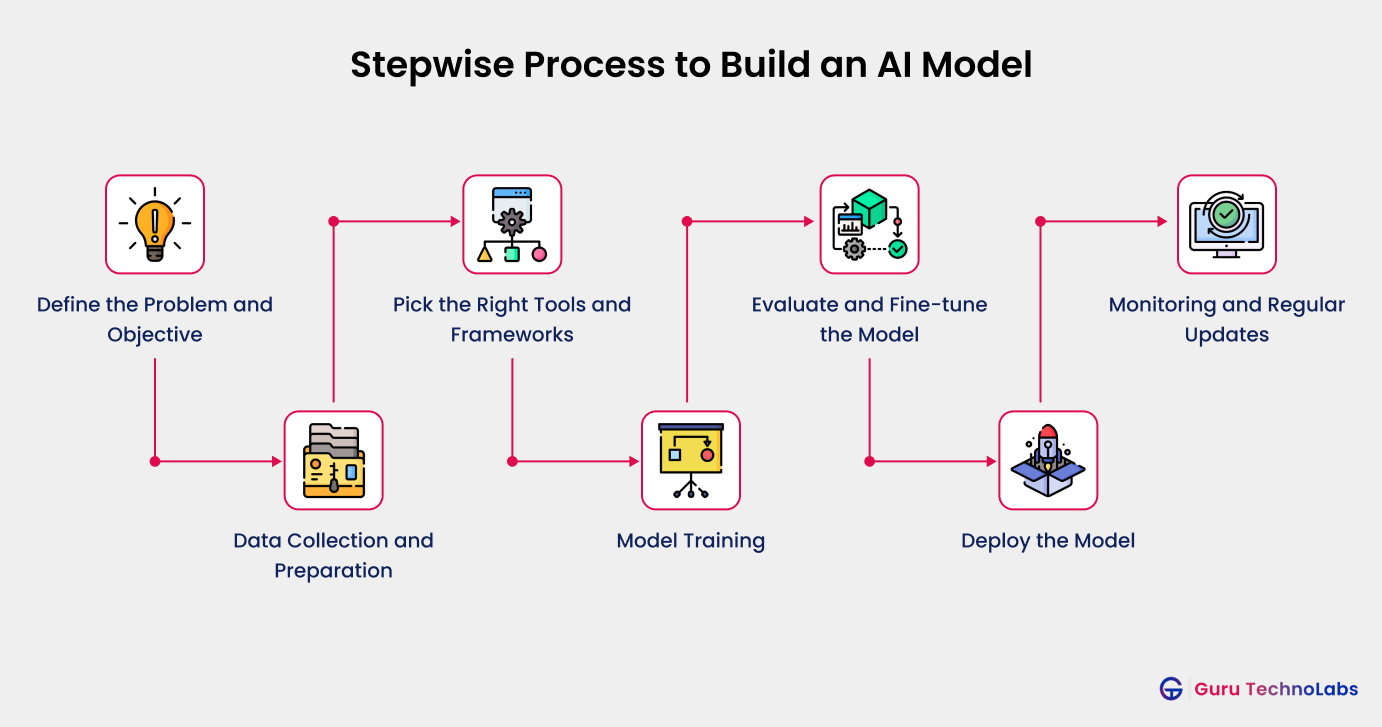How to Create an AI Model: A Definitive Guide for 2025

AI is reshaping the future, and those who harness its power will lead the way. By 2025, artificial intelligence will be more than just a buzzword, it will be a dominant force transforming industries, from healthcare and finance to entertainment and education. The global AI market is anticipated to reach an astounding $190 billion by 2025, with a CAGR of 35.7%. This rapid growth signifies a technological revolution, making AI the cornerstone of innovation and success in the modern world.
As AI continues to evolve, experts are calling for a mindset shift.
“AI is not a threat, it’s an opportunity”, says Sundar Pichai, CEO of Alphabet Inc.
The real question isn’t whether we can adapt to AI, it’s how fast we can accept and start building with it. The best way to get ahead is to roll up your sleeves and experiment with AI yourself, as pioneers like Elon Musk and Demis Hassabis have done.
This article serves as a guide that breaks down the process step by step that will help you create an AI model. By the end, you’ll know exactly how to not only survive this new age of technology, but thrive in it. Curious to know more? Let’s get started.
What is an AI Model?
An AI Model is a system that is trained to make predictions, predictions, or perform tasks by learning from data. So, there you go. It’s as if you teach a computer by experience, you teach computers by data.
That is, in health care, where physicians utilize artificial intelligence models to spot early indications of illnesses (like cancer) by examining medical images or forecasting patient outcomes based on previous statistics.
High-quality data is required for AI models to make accurate predictions. It gives these models exposure to historical data and allows them to learn how certain patterns and trends may lead to particular outcomes.
This “predictive power” enables organizations to anticipate potential risks and anticipate problems before they arise.
Neural networks, for instance, can assist doctors in interpreting medical scans with greater precision. From Finance to Healthcare and Marketing more AI models are rapidly proving to be essential tools for transforming your industry.
5 Layers Essential to Building an AI Model
Building an AI model involves multiple layers of technology and processes, each playing an important role in making sure the model works efficiently and accurately.
Also read: AI Technology Stack: Complete Guide to Build AI Solutions
Data Layer
The data layer is the backbone of every AI model. It includes retrieving and preprocessing the raw data needed to train our model. Data is the core component for prediction and model training, therefore needs to be high quality, diverse, and clean.
This layer is typically where data preprocessing steps such as normalization, feature selection, and data augmentation are applied to prepare the data for examination.
Infrastructure Layer
This layer supplies the compute and resources to execute AI models. It encompasses hardware elements such as servers, GPUs, and cloud resources to enable rapid execution of extensive datasets and intricate computations.
The infrastructure like PyTorch, TensorFlow, and CUDA to construct and speed up research.
Model Layer
This is the layer where the real magic happens. The real machine learning model learns from data and makes predictions. This layer builds models using algorithms such as decision trees, neural networks, or support vector machines.
It involves selecting the right model architecture and hyperparameters to improve performance and reduce errors.
Training Layer
Once the data and model are in place, the training layer kicks in. Here, the model undergoes an iterative process where it learns from the training data by adjusting weights and biases to minimize errors.
This layer also involves validation and fine-tuning to optimize the model’s performance using techniques like cross-validation and gradient descent.
Application Layer
The application layer is where the AI model is deployed and integrated into real-world applications. This layer allows businesses or users to access the model’s predictions through interfaces, APIs, or dashboards.
It ensures that the AI model can scale, be accessed by other systems, and deliver actionable insights efficiently to end-users. For businesses aiming to take full advantage of these capabilities, learning how to integrate AI into an app is a crucial step toward creating smarter, more user-friendly solutions.
These five layers form the backbone of any AI project, for businesses looking to build successful AI solutions, partnering with an AI development company can help streamline this process and bring expertise to each layer, ensuring optimal performance and seamless integration into your systems.
For organizations with unique requirements, it’s also beneficial to build custom AI software that aligns precisely with their goals, offering greater flexibility and innovation.
Want to Know, How can You Integrate AI into Your Platform?
Connect with us! Our experts will help integrate AI to improve user experience,
increase efficiency, and help your dating platform succeed.
Stepwise Process to Create an AI Model
Creating an AI model is a systematic and iterative process that requires careful planning and execution. By following a clear stepwise approach, you can ensure that each stage of the development is properly handled to create a robust, effective AI model.
Here’s how you can break down the process:

Define the Problem and Objective
The first step in building an AI model is to clearly define the problem you’re trying to solve. Evaluating the goals and outcomes you plan to achieve along with the challenges you encounter.
This clarity will direct your efforts, ensuring the accomplishment of your business goals. Collaborate with experienced professionals to help you build a generative AI solution backed by deep knowledge and a strategic roadmap.
Data Collection and Preparation
While building an accurate AI model, quality data is critical to feed it. To solve any given problem, this may involve collecting relevant datasets like user behavior, transaction history, or any domain-specific data.
If you don’t have a sound method to collect data, there’s no way to guarantee that you will have a wide and exhaustive dataset to work with. The next step after the data has been collected is to clean and preprocess it. Overlooking this step can lead to models that learn from redundant information, which reduces their noise-tolerance capabilities and predictive efficiency.
To illustrate, in a sales prediction model data may come from historical sales transactions and customer profiles that need to be cleaned and processed before being input to the AI model.
Pick the Right Tools and Frameworks
This step comes down to what tools/framework to use. TensorFlow is chosen by the hospital to contain as it is scalable and flexible, thus allowing the brands to build a predictive model that suits complex medical data.
They also leverage Python libraries like Pandas and Scikit-learn for data manipulation and classical machine learning algorithms.
- TensorFlow: Deep learning framework used for building neural networks
- Pandas: Python library for data manipulation and analysis
- Scikit-learn: Provides traditional machine learning models like regression and decision trees
Model Training
After selecting the appropriate tools, the hospital begins training the AI model using the prepared dataset. The model learns from historical patient data, identifying patterns associated with high-risk readmission.
The training process involves tuning model hyperparameters and validating its performance on unseen data to ensure it generalizes well. The model is iteratively refined to maximize prediction accuracy.
- Algorithm: Use a decision tree or logistic regression model for classification
- Training Process: Train the model using labeled data (patient data with readmission outcomes)
- Validation: Use cross-validation to ensure the model generalizes well and avoids overfitting
Evaluate and Fine-tune the Model
Once the model is trained, the next step is to evaluate its performance. If the model underperforms, the team may adjust its parameters, try different algorithms, or collect more data for training. The goal is to achieve high accuracy, ensuring the model provides valuable predictions for readmission risk.
- Evaluate the model’s performance using metrics like accuracy, precision, recall, and F1 score
- Fine-tune by adjusting hyperparameters or using different machine-learning techniques (e.g., Random Forests)
- Continuous testing on new datasets to track the model’s performance over time
Deploy the Model
Once the AI model is fine-tuned and performed optimally, it’s time to deploy it into the business’s existing system. The brand can use cloud-based platforms like AWS or Google Cloud to deploy the model and make it accessible to healthcare providers in real time.
The model can now provide predictions for new customers and help brands make informed decisions on whether additional technique is needed. Ongoing monitoring and updates are essential to maintain the model’s performance.
- Deployment: Host the model on cloud platforms like AWS or Azure for real-time predictions
- Integration: Integrate the AI model into existing systems for seamless access by organizations
- Continues Monitoring: Track model performance and retain as new data is collected
Monitoring and Regular Updates
After deployment, it’s important to continuously monitor our AI model. This includes tracking its performance, finding errors or anomalies, and making necessary changes.
Model tools like TensorFlow’s TensorBoard or Google’s Cloud monitoring can be helpful in this process.
Regular updates may be necessary to maintain top-notch performance as technology advances.
Frameworks and Tools to Develop an Innovative AI Model
To build an AI model, selecting the right tools and frameworks is important, as they provide the necessary functionalities for data processing, model training, and deployment.
Here are the top 15 frameworks and tools to consider when developing AI models:
1. TensorFlow
TensorFlow is an open-source framework built by Google mainly for deep learning models.
2. PyTorch
Another popular deep-learning framework is PyTorch, developed by Facebook. It has a very simple interface and, as such, is popular among researchers and developers using it to train AI models quickly.
3. Keras
Keras is a high-level API for neural networks that runs on top of TensorFlow.
4. Scikit-learn
Scikit-learn is a Python library for classical (non-deep) machine learning algorithms (regression, clustering, classification, etc.)
5. MXNet
MXNet is a scalable deep learning framework that is scaled from multiple devices.
6. H2O.ai
H2O. ai is an open-source machine learning framework for developing neural network models. As a result, it is popular for building AI models quicker, providing tools like H2O AutoML that assist with the automation of the complete model building and optimization process.
7. FastAI
FastAI is a high-level deep-learning library over PyTorch. It is also designed to make it easier to train neural networks, providing high-level components in place for developers to get the most out of their data with the minimum amount of code.
8. Google Cloud AI Platform
Google Cloud AI platform provides a variety of AI tools for model building, training and deployment. It includes pre-built models and allows you to customize and scale AI solutions, leveraging Google’s powerful cloud infrastructure.
9. Apache Mahout
Apache Mahout is a machine-learning library built on top of Hadoop and designed for scalable machine-learning algorithms.
10. OpenCV
OpenCV is an open-source computer vision library that provides tools for real-time image and video processing.
11. Microsoft Azure AI
Microsoft Azure AI provides a suite of tools and services for building AI models. It includes Azure Machine Learning, a platform that offers both code-first and low-code tools for developing, training, and deploying models.
12. Theano
Theano is a Python library for numerical computation that allows you to define, optimize, and evaluate mathematical expressions efficiently.
13. Amazon SageMaker
Amazon SageMaker is a fully managed service from AWS that allows data scientists and developers to build, train, and deploy machine learning models.
14. Caffe
Caffe is an open-source deep learning framework known for its speed and efficiency, especially in image processing tasks.
15. Apache-spark
This tool is an open-source distributed computing system that provides an interface for programming entire clusters.
These tools and frameworks provide a range of capabilities from deep learning to classical machine learning and big data processing, giving developers the flexibility to create innovative AI models tailored to specific business needs.
Challenges Associated with Creating Your AI Model
Making an AI model from scratch is a rewarding process, but it does come with certain challenges such as:
- Data Quality: High-quality data is essential for accurate AI models. Poor and wrong data can lead to biased and incorrect results.
- Computing Power: AI training requires certain computational resources, especially for deep learning models. Cloud-based solutions can help overcome this issue.
- AI Expertise: While AI frameworks make it easier to create AI models, however, you need to hire a dedicated development team for advanced AI projects.
How Much Does It Cost to Develop an AI Model?
Developing an AI model is a complex and resource-intensive process that can come with significant costs. These expenses arise from multiple areas including data acquisition, model development, training, computational infrastructure, and ongoing maintenance.
The overall cost can vary based on the scope of the project, the complexity of the AI model, and the resources required at each stage.
Summary of Key Cost Drivers
- Data Acquisition and Preparation: High costs for data gathering, cleaning, and labeling.
- Algorithm Development and Training: Specialized tools and talent, plus significant computational power.
- Computational Resources: Costs for cloud services, GPUs, and data storage.
- Expertise: Hiring skilled professionals to develop, refine, and manage the AI model.
- Testing, Iteration, and Evaluation: Continuous improvements and validation to ensure model reliability.
- Deployment and Integration: Costs for integrating the AI model into existing systems.
- Maintenance and Updates: Ongoing model refinement to ensure it adapts over time.
-
In conclusion, the total cost of developing an AI model depends on several factors, ranging from the complexity of the model to the required resources and expertise. Planning for these costs in advance can help businesses ensure they have the right budget and strategy to implement AI successfully.
By understanding and managing these costs effectively, organizations can not only build powerful AI models but also sustain their value over the long term.
Create an Accurate and Scalable AI model with Guru TechnoLabs
Developing a powerful and scalable AI model is no small feat. It requires a deep understanding of data science, machine learning algorithms, computational resources, and continuous model optimization.
At Guru TechnoLabs, we bring together years of expertise in AI and machine learning to help businesses build models that are not only accurate but also adaptable to evolving needs.
By partnering with a renowned AI and ML development company like Guru TechnoLabs, you gain access to the best tools, frameworks, and a proven methodology for building AI models that drive measurable business outcomes. Contact us today to leverage our expertise and create an AI model that enhances efficiency, drives innovation, and delivers long-term success for your business.
Frequently Asked Questions
An AI model is a mathematical representation of a process or system that uses algorithms and data to make predictions or decisions. It is trained on large datasets and can improve over time by learning patterns and trends from new data.
AI model development refers to the process of creating, training, and fine-tuning machine learning or deep learning models to solve specific tasks.
AI models work by learning from data through training. They identify patterns and correlations within the data, enabling them to make predictions or decisions.
To develop an AI model in Python, you typically use libraries such as TensorFlow, PyTorch, or Scikit-learn. Start by collecting and preprocessing your data, then choose a suitable algorithm, train the model, and evaluate its performance before deploying it.
Here are some common types of AI models:
-
Supervised learning models
Unsupervised learning models
Reinforcement learning models
Neural networks
Generative models















